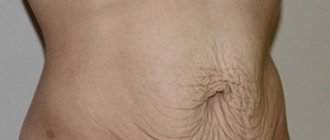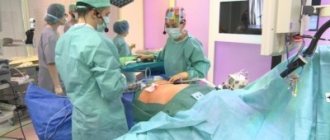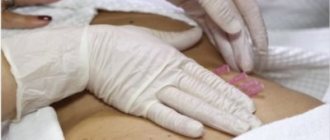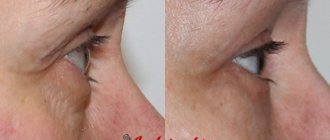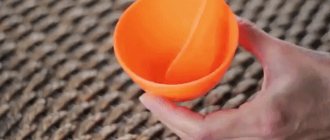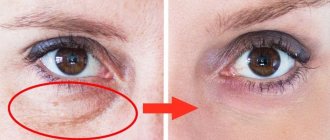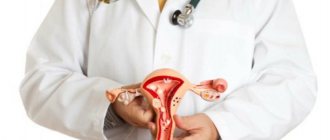Abdominoplasty is a fairly complex surgical operation and has a long recovery period. This is normal because in some cases, tummy tuck surgery requires extensive surgery and the patient will need more time to recover.
After the operation is completed, the patient will remain in the hospital for another 1-3 days. The duration of hospitalization depends on the scale of the operation and the patient’s condition after it. During abdominoplasty, the patient is given drains - these are special silicone tubes that help remove fluid accumulated in the operated area. Drains are removed either 2-3 days after surgery, or during the first dressing.
After abdominoplasty, bandaging is done two to three times a week. This procedure is repeated until the sutures are removed, which occurs approximately two weeks after the operation. In most cases, when performing tummy tuck, self-absorbable threads are used, which will disappear on their own after some time and do not need to be removed.
Typically, the rehabilitation period depends on the scope of the operation, the patient’s age and health status.
You should be prepared for the fact that in the first few days of rehabilitation after abdominoplasty you will experience pain in the abdominal area, as well as post-operative swelling. Pain syndrome is relieved with the help of drugs with analgesics. During the recovery period, the doctor will prescribe painkillers and antibacterial drugs, and a special diet. During this period, it is necessary to exclude physical activity.
In order for the rehabilitation period after abdominoplasty to proceed efficiently and to see the results of the correction as quickly as possible, it is important to strictly follow the recommendations of the plastic surgeon and follow all the necessary rules.
Important rules for rehabilitation after abdominoplasty
After abdominoplasty, the patient will have to lie and sleep only in a half-bent position, sit and walk - bending the torso forward and bending the leg slightly. The first days you need to sleep on your back with your legs bent. This position of the body should be accepted not only because it is painful to straighten up after tummy tuck; also the fact is that the postoperative suture is in unfavorable conditions. The skin in the abdominal area is constantly stretched and, accordingly, the seam also stretches and expands. If you straighten up during this period, the skin of the abdomen will begin to stretch and instead of a barely noticeable scar as thick as a thread, you will get a large and unsightly scar. To prevent this from happening, for the first 3 months it is forbidden to lift weights and actively engage in sports or expose yourself to other heavy physical activity. However, it will be necessary to perform a set of exercises that the plastic surgeon will recommend.
It is important to know that during the rehabilitation period after abdominoplasty, as after any other surgical intervention, the following rules must be followed:
- Avoid visiting solariums and beaches;
- Do not take hot baths or contrast showers;
- Compression garments should be worn for 3-4 months after surgery.
Is there a difference between female and male abdominoplasty?
Surgical correction of the abdominal wall is equally popular among both men and the fair sex. The difference lies initially in the anatomical structure - men and women have different distributions of fatty tissue. Women have a gynoid type of fat distribution, when the most pronounced thickness of subcutaneous fat is concentrated in the lower part of the body, in the lower abdomen, on the upper third of the inner surfaces of the thighs and buttocks.
Men are characterized by a more uniform distribution of fat depots. This includes the cervical area, the back of the head, the chest, the lumbar region, and the upper part of the abdominal wall. In men, unlike women, fatty tissue in the abdominal area accumulates in the omentum of the abdominal cavity; over time, the skin here stretches and sags. The accumulation of visceral fat located inside the abdominal cavity is another male feature. The so-called “beer belly” is an android type of obesity.
But still, when performing abdominoplasty in men and women, there are some differences. For example, the presence of hair in men in the abdominal area. The postoperative period and healing are easier for women, but they develop keloid scars more often.
What are compression garments
Compression garments are special underwear that support muscles and other tissues that have been affected by surgery. Compression underwear is made from elastic, breathable fabrics, which ensures constant air exchange. Special fabric allows you to support the skin and muscles after plastic surgery.
Compression garments cover an area of the body and create constant and even pressure from different sides. This provides support for the entire operated area for patient comfort.
The optimal pressure level (17-20 mm Hg) helps the patient maintain the silhouette created by the plastic surgeon.
How long have plastic surgeons been performing abdominoplasty?
The first operations to remove tissue from the abdomen began to be performed at the beginning of the 19th century. Since then, the number of techniques has increased so much that it is impossible to list them even in one day, our expert assures. The evolution of this trend in plastic surgery was gradual. First, the routes of access or incisions were improved, and each doctor contributed here. Then – correction techniques. As a result, the traditional method of incision was formed, which is a low access above the pubic line, in the bikini area, which is easily covered by underwear.
Why is it important to wear compression garments?
During the operation, trauma to tissues and blood vessels occurs. Liquid from injured vessels and capillaries begins to penetrate into the tissue and accumulate. This condition interferes with the healing process. In addition, excess fluid can provoke the development of infectious processes and wound dehiscence. During abdominoplasty, a large amount of skin and fat tissue is lifted, creating space for fluid to accumulate.
After an abdominoplasty, compression garments are used to reduce swelling, reduce discomfort, and also support the tissue while it is in the healing process. Compression garments are worn immediately after surgery. After the swelling disappears, the underwear supports the anterior abdominal wall. Many patients who did not wear compression garments reported that they experienced pain in the first weeks after tummy tuck.
The recovery period after abdominoplasty takes several weeks, and the final result can only be seen after several months. Wearing compression garments from the first days of recovery after abdominoplasty will help reduce swelling and provide comfort to the patient.
Compression garments have a beneficial effect on the healing process. Firstly, bandages and dressings are hidden and remain in place, they do not get dirty, which reduces the risk of infection in the wound. Secondly, the pressure exerted by compression garments accelerates scarring of the stitches after abdominoplasty. Uniform pressure reduces the likelihood of the formation of keloid and hypertrophic scars and has a beneficial effect on the scarring process. After abdominoplasty, you must follow a special diet. Compression garments will help you control the amount of food you eat, signaling when your stomach is full.
It will be possible to remove compression garments for a short period of time (for example, to take a shower) only 10-14 days after the operation. During the first month, while washing and drying clothes, if the patient does not have a spare set, it will be necessary to take a horizontal position, without leaving the stomach upright without support.
Abdominoplasty: how is it done?
Abdominoplasty is a multicomponent operation. If a patient has a request to remove a large flap, it can begin with liposuction - pumping out fatty tissue. Next, according to the markings made by the surgeon in advance, an incision is made. The skin-fat flap is peeled off, preserving the lymph structure, in order to avoid unpleasant consequences in the form of seroma.
“A seroma is an accumulation of lymph fluid between layers of tissue as a result of surgery. According to statistics, this complication occurs in 50% of patients, warns Yuri Mirzabekyan. “There’s nothing wrong with it if it’s treated and drained in time.”
The duration of the operation may vary, depending on the complexity of the goals. In some cases it can take 8 hours or even more.
One of the important stages in abdominoplasty is suturing the diastasis - the rectus abdominis muscles. With diastasis, the abdominal muscles seem to move apart in different directions. This defect can be seen through the skin if the diastasis is strong. Weakening of these muscles occurs in women who have given birth, so if a woman undergoes abdominoplasty after childbirth, special attention is paid to this stage. There are several methods for suturing diastasis: it can be sutured with non-absorbable threads, or a special mesh implant can be applied to give rigidity to this frame. The choice depends on the surgeon.
The excess skin apron is then removed by excision. The wound is sutured with the insertion of drains, which remain in the wound until less than 50 ml of ichor is released through them. As a rule, this happens on the second day.
Possible complications after abdominoplasty
- After tummy tuck, like after any other surgical operation, swelling appears, which can last up to 8 months.
- If a large amount of serous fluid accumulates in the operated area (seroma), a puncture may be performed to remove it.
- There may be partial loss of sensation in the surgical area, which will recover over time. The period of loss of sensitivity can last from two months to a year.
If you follow all the rules and recommendations of the doctor, the postoperative scar will gradually begin to lighten and in a year will be almost invisible.
To speed up the scarring process, you can use special creams and ointments. Using a silicone patch helps make the scar as invisible and neat as possible. If desired, you can get rid of the postoperative scar completely by getting a tattoo in this area or using laser correction.
It should also be taken into account that when planning a pregnancy, it is better to postpone abdominoplasty until after childbirth, because Delivery will worsen the outcome of the operation. If the patient has planned a pregnancy after tummy tuck, it is advisable that at least a year pass from the moment of surgery to the birth.
What types of abdominoplasty are there?
Our expert Yuri Merzabekyan identified the following types of this operation: “There is abdominal surgery with transfer of the umbilical ring, with sufficiently large volumes of tissue excision. The navel is formed in a new place. And also without transferring the umbilical ring, when the volume of the skin-fat apron is small. There is also a mini abdominoplasty, which removes a section of skin up to the belly button.”
Endoscopic techniques are increasingly being used to close the aponeurosis, the tissue that covers the muscles. A small incision is made near the navel, and if necessary, some mesh is applied. And under the control of an endoscope, the aponeurosis is sutured. If there are hernias, they are also removed.
With classic tummy tuck, a noticeable incision is made in the bikini area and the tissue is peeled off. Often, the doctor also performs liposuction with the traditional option.
Another type of abdominoplasty is simultaneous, that is, combined with other types of plastic surgery, for example, mammoplasty.
After a mastectomy, the surgeon can take a flap from the anterior abdominal wall to reconstruct the breast.
Cost of combined surgery (liposuction + abdominoplasty)
With the help of plastic surgery, it becomes possible to obtain a good result of figure correction in cases where conservative methods (diet, sports and cosmetic procedures) are ineffective. Surgery will help eliminate excess sagging skin and restore muscle tone, and abdominal liposuction will help to cope with significant fat deposits. The price will depend on the volume of problem areas and the need for additional procedures (hip liposuction, hernia removal, etc.).
Paying for beauty: how much does it cost and how long does the result last?
The level of costs for the operation, hospital stay, anesthesia, tests and related services can be determined based on the type of operation. First you need to consult a surgeon. On average, the price starts at 140 thousand rubles. You can find out approximate prices on the websites of clinics that practice abdominoplasty, and see before and after photos there.
It is difficult to decide on an operation; you are afraid of anesthesia, post-operative recovery, and the considerable cost of the procedure. However, the results of abdominoplasty will last for years to come; this is a reasonable investment in maintaining slimness.
Choosing a method for performing abdominoplasty
The choice depends, of course, on the situation. Thus, extended liposuction with suturing of diastasis is considered abdominoplasty. It is indicated for patients in whom large amounts of fat can be successfully removed without interventions on the skin and muscular aponeurotic framework.
During mini-abdominoplasty after liposuction, a skin-fat flap is mobilized through a small transverse or vertical incision and, under endoscopic control, diastasis of the rectus abdominis muscles is eliminated and excess skin is removed.
There is also a modified abdominoplasty using endoscopy. The indication for such an operation is minimal excess skin and weakness of the muscular aponeurotic system. Before starting, liposuction is usually done to get to the muscles, then these muscles are sutured.
The choice remains with the surgeon, who must clearly understand the scale of the operation in order to achieve the optimal result. The quality of the skin, its ability to contract, and muscle tone are taken into account.
“I would especially like to mention such a method as lipofilling, liposculpture,” continues Yuri Mirzabekyan. – This method involves transplanting fatty tissue from one area of the body to another in order to increase the volume of that area. As a rule, the buttocks are enlarged. Fat is also injected into the contours of the implanted mammary glands, into the hands, and into some areas of the face. Young patients sometimes ask for an imitation of an athletic abdomen; muscles are simulated on the anterior abdominal wall. Fat grafting will also help smooth out scars.”
Photo
The photo shows what the abdomen looks like before surgery and after plastic surgery.
From special publications on our website you will learn in what cases tummy tuck is performed and what types of operations are performed for those who have recently given birth, as well as what mini-abdominoplasty is.
Traces for memory: scars and cicatrices
Traces from abdominal abdominoplasty, shown in the before and after photos, become less noticeable after a while thanks to the professional work of surgeons. The use of high-quality suture material and a special technique for suturing surgical incisions helps to obtain a thin strip at the site of the scar.
The condition of the suture is carefully monitored in the first weeks after surgery. Skin sutures must be removed after 2 weeks; intradermal sutures made with self-absorbing sutures or adhesive sutures should not be touched, only processed.
If the abdominoplasty was very serious, before and after photos show the difference, and the scars are visible, you can resort to modern cosmetology. To eliminate scars and scars, laser resurfacing and radiolifting procedures or retouching with medical tattooing for an aesthetic appearance are used.
When will the results of tummy tuck be visible?
After 10-15 days you can return to your normal life. Physical activity and exercise are prohibited for 2 months.
The first changes are visible immediately. The best results are achieved in patients with normal weight. The persistence and effectiveness of the changes is quite high, but may vary due to fluctuations in body weight and subsequent pregnancies.
Type of scars 1 year after surgery
What are the possible contraindications for abdominoplasty?
General contraindications for abdominoplasty are organic diseases of the cardiovascular and respiratory systems. “I’ll explain why: when the volume of the abdomen decreases, breathing becomes a little difficult. Lung excursion - the distance by which the lower border of the lungs shifts during respiratory movements (maximum inhalation and maximum exhalation) will no longer be so free. Many clinics conduct special training for patients before a large volume of abdominoplasty to make it easier for them to breathe. Patients wear special compression suits and bandages to train their respiratory system,” says Yuri Mirzabekyan.
Uncompensated diabetes mellitus may also be a contraindication, since the disease will affect wound healing. Allergic reactions, diseases of the nervous system, viral and intestinal diseases, renal failure, dermatitis, psoriasis - all this can cause refusal to undergo surgery.
Among the temporary contraindications are menstruation, 10 days before its onset and 5 days after. This also includes pregnancy planned in the near future and taking anticoagulants. And finally, the worst enemy of plastic surgeons is smoking, which negatively affects healing.
